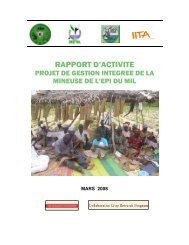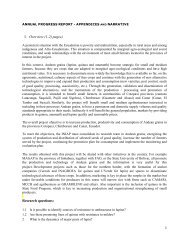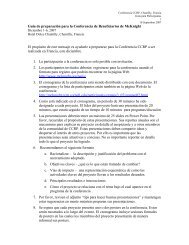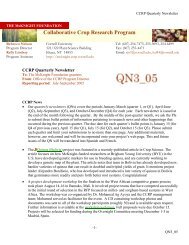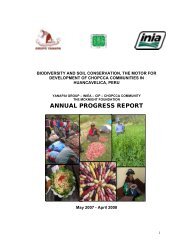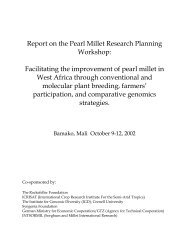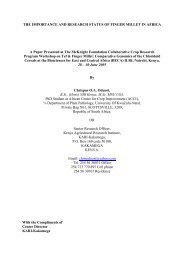English - McKnight Foundation Collaborative Crop Research Program
English - McKnight Foundation Collaborative Crop Research Program
English - McKnight Foundation Collaborative Crop Research Program
Create successful ePaper yourself
Turn your PDF publications into a flip-book with our unique Google optimized e-Paper software.
<strong>McKnight</strong> <strong>Foundation</strong> <strong>Collaborative</strong> <strong>Crop</strong>s <strong>Research</strong> Project No: 06-741<br />
cowpea products based on the training made by the project and shared this with participants (Figure 1).<br />
In addition, the project team participated at a national agriculture fair, alongside the <strong>Crop</strong> Science<br />
Department. Again, the focus of the exhibit was of utilization. The exhibits attracted a lot of attention<br />
from participants.<br />
Figure 1. Farmer group displays of cowpea recipes (left) and cross section of participants (right)<br />
at ADD – wide show in Lilongwe.<br />
4.3 Group dynamics training for farmers in Ngwangwa<br />
Group dynamics training was conducted for all the farmers in the two participating villages in<br />
Mgwangwa. The training was conducted in August 2009. The training was provided on group<br />
leadership and operation. This group strengthening included membership and responsibilities,<br />
constitution, networking and fund raising to sustain the groups.<br />
4.4 Workshops on cowpea market value chain<br />
Cowpea market value chain workshops were conducted in Lilongwe and Zomba in August 2009. These<br />
workshops were held following the conclusion of a market survey. As per project document, the,<br />
meetings were held to bring together representatives of cowpea producers, middlemen and traders. The<br />
objective was to link producers better to the market and identifies increased marketing opportunities.<br />
There were lead presentations made by project team theme leaders as follows:- a) a presentation on<br />
cowpea production trends, production requirements, cowpea agronomy, potential yields reasons for low<br />
yields in Malawi and cowpea storage Mr E. Mazuma; b) a presentation on cowpea utilization, including<br />
nutritional value, processing of leaves and grain, utilization as animal feed by Dr Mangwela and c)<br />
presentation on cowpea preferences and marketing by Mr Thabie Chilongo. At both venues there were<br />
representatives of farmers, government extension, NGO’s, agricultural input suppliers, traders and<br />
researchers.<br />
The workshop revealed that there are six big business traders who buy cowpea seeds (ADMARC, Rab<br />
Processors, Mulli Brothers, Agora, Grain Traders Association, and Transglobe). Many of them placed<br />
emphasis on large seeded grain types as preferences. A representative of ADMARC indicated that this<br />
season they have been instructed to buy large seeded cowpea only. The traders acknowledged that they<br />
don’t buy much cowpea, but that the markets were small as well thus can satisfy it. Some cowpea is<br />
sold locally (for cakes and cookie making) while most of it is exported. However, it was noted that most<br />
of the cowpeas are traded in local markets with no clear records on volumes and quality requirements.<br />
At the meetings we displayed a draft version of our booklet on cowpea production and utilization. The<br />
participants demanded speedy release of this book. The nutrition officers collected the draft copies for<br />
immediate use. The workshops also noted that there are many reasons for variety choice amongst<br />
40<br />
2009



